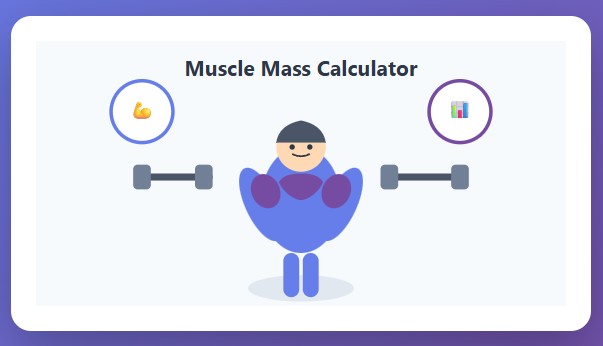Best Tool for Muscle Mass Calculator
Calculate your lean body mass, muscle mass percentage, and body composition with our advanced calculator. Get personalized insights to optimize your fitness journey.
Calculate Your Muscle Mass
Your Results
Why Calculate Your Muscle Mass?
Understanding your muscle mass is crucial for optimizing your fitness journey, health, and overall well-being. Muscle mass isn’t just about aesthetics—it plays a vital role in metabolism, strength, longevity, and disease prevention.
Muscle tissue burns more calories at rest than fat tissue, helping you maintain a healthy weight and body composition.
Monitor your muscle gain or loss over time to ensure your training and nutrition plan is working effectively.
Understand your current muscle mass to set achievable, personalized fitness goals based on your unique body composition.
Optimal muscle mass enhances athletic performance, functional strength, and daily movement efficiency.
Adequate muscle mass supports joints, improves balance, and reduces the risk of falls and injuries.
Higher muscle mass is associated with better insulin sensitivity, cardiovascular health, and longevity.
How the Calculator Works: Our advanced muscle mass calculator uses scientifically validated formulas including the Boer formula for lean body mass calculation. When you provide your body fat percentage, we can calculate your exact muscle mass. Without it, we estimate using age and gender-specific algorithms developed through extensive research.
The calculator considers multiple factors including your gender, age, weight, height, and optional body fat percentage to provide accurate estimates of your lean body mass, muscle mass, and recommended protein intake for your goals.
Expert Tips for Building Muscle Mass
- 1
Progressive Overload is Key
Gradually increase the weight, reps, or intensity of your workouts over time. Your muscles need consistent challenges to grow. Aim to add 2.5-5% more weight or 1-2 additional reps each week on your main lifts.
- 2
Prioritize Protein Intake
Consume 1.6-2.2 grams of protein per kilogram of body weight daily. Distribute protein evenly across 4-5 meals for optimal muscle protein synthesis. Quality sources include lean meats, fish, eggs, dairy, legumes, and protein supplements.
- 3
Don’t Neglect Rest and Recovery
Muscles grow during rest, not during workouts. Aim for 7-9 hours of quality sleep per night, and allow each muscle group 48-72 hours of recovery between intense training sessions. Consider active recovery days with light cardio or stretching.
- 4
Master Compound Exercises
Focus on multi-joint movements like squats, deadlifts, bench press, overhead press, and rows. These exercises recruit multiple muscle groups simultaneously, producing greater hormonal responses and overall muscle growth compared to isolation exercises.
- 5
Maintain a Caloric Surplus
To build muscle, you need to consume slightly more calories than you burn—typically 200-500 calories above maintenance. Focus on nutrient-dense whole foods including complex carbohydrates, healthy fats, and plenty of vegetables for vitamins and minerals.
- 6
Stay Consistent
Muscle building is a marathon, not a sprint. Expect to gain 0.5-1 kg of muscle per month as a beginner, less as you become more advanced. Stay consistent with training, nutrition, and recovery for at least 3-6 months to see significant results.
- 7
Hydration Matters
Proper hydration is crucial for muscle function and recovery. Aim for at least 3-4 liters of water daily, more if you’re training intensely or in hot conditions. Dehydration can impair performance and slow muscle growth.
- 8
Track Your Progress
Keep detailed records of your workouts, body measurements, and progress photos. Use this calculator monthly to monitor changes in muscle mass. Tracking helps you identify what’s working and adjust your approach when needed.


